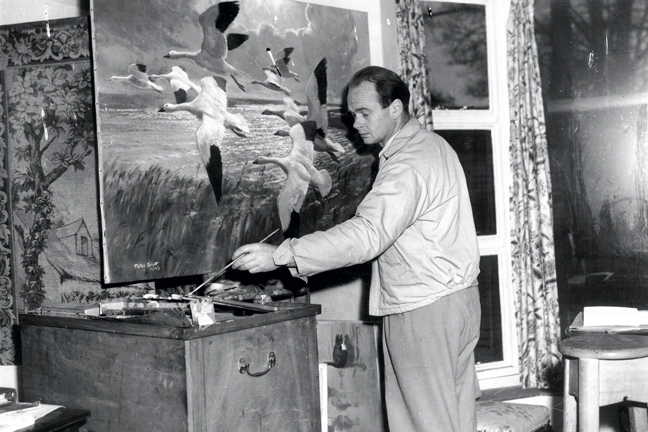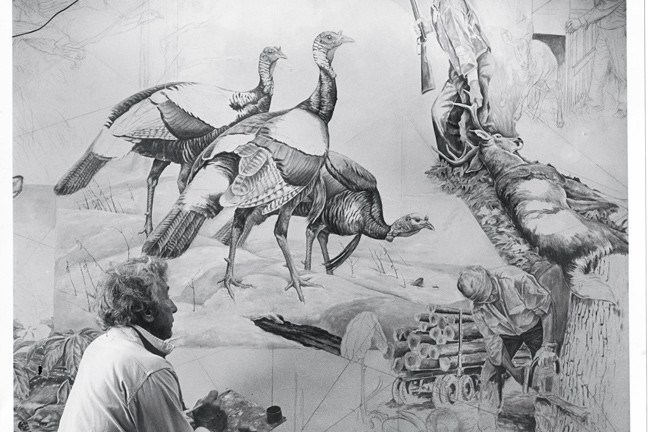The bond between Missouri and England's Sir Peter Scott is long and strong. First there is a deep mutual admiration for the artistic talents of Scott by the late Charles W. Schwartz, a close friend and fellow conservationist. "He's the greatest waterfowl artist in the world," Schwartz said.
Scott, son of famed polar explorer Robert Falcon Scott, carved a powerful reputation. The younger Scott established a network of waterfowl refuges in the British Isles. In England he is widely called "one of the fathers of modern conservation," a description he shares with America's Aldo Leopold.

Scott, born in 1909, barely knew his famous father, but the elder Scott left an indelible legacy. In a letter, Robert urged his wife to "make the boy interested in natural history."
Sir Peter obliged his father, founding the World Wildlife Fund, leaving a legacy of wetland conservation in the UK and hosting one of the first wildlife television shows anywhere.
In the 1950s Scott developed a revolutionary rocket system for propelling a net over feeding waterfowl so they could be studied and identified. It was sometime imperfect—the rockets misfired or sailed off in unpredictable directions. Popular Mechanics documented Scott's method of catching geese and a couple of Missourians took notice.
At the Swan Lake NWR, consummate tinkerer Howard Thornsberry and his boss, Herb Dill, were working on a similar idea. Instead of rockets they used a form of mortar to fire the net. "We certainly don't credit Peter Scott with any portion of the origin of the 'boom trap' which was developed and operated at Swan Lake shortly before we saw an account of Scott's work," Dill said.
HEAVY NETS
Scott visited Swan Lake in 1950 and saw what Dill and Thornsberry were doing with their pyrotechnic trap. Regardless of who did what when, wildlife management took a giant step forward. Thornsberry thought he could improve on the rocket net and invented a sort of mortar that lofted the weighted ends of a net over the resting birds. The "cannon net" still is the most widely-used trap system today, helping aid in the restoration of the wild turkey.
The cannon net has been used to capture not only geese and turkeys but also large animals. Once they're netted, they can be banded or radio monitored, like a 30-year-old banded barnacle goose that arrived at Caerlaverock Wetland Centre, one of Scott's network of refuges, in 2014.
In the 1940s Schwartz and his wife Elizabeth (Libby) did a year-long study of Hawaii wildlife, often camping and living off the land. One of the more plentiful food sources were pheasants. "I got really tired of eating pheasants," Charlie said.

One thing they didn't eat were Nene geese, on the brink of extinction. Hawaii's state bird (since 1957) had been common a few centuries before. A theory is the Nene evolved from Canada geese long ago.
The Nene flock was down to an estimated 30 birds when Scott contacted Schwartz to see if he could arrange for live geese or eggs to be transported to England and his Refuge at Slimbridge. The details of the transfer are hazy, both among the Schwartz family and officials at Scott's Wetland Waterfowl Trust. It might have been an egg transfer or a couple or three live birds, but the bottom line is that the geese began to multiply and today the flock tops 3,000. Visitors to Slimbridge mingle among the Nene geese that are ever alert for any dropped morsel of food.
Scott and Schwartz shared an affinity for geese. Both frequently painted geese. Scott was the Savior of the Nene and Schwartz made a movie about Canada geese (Wild Chorus, which won the Outdoor Writers Association of America best wildlife film award in 1974). After a filming session on Hudson Bay Charlie and Libby smuggled several baby Canada geese across the border, nestled in their down (goose) jackets. When the goslings would peep everyone would talk or cough or sneeze, anything to mask the sound of the little birds.
"What the heck," Charlie said, "geese fly across the border both ways and no one checks their passports."
They got away with their minor crime and the geese became Charlie's family. He learned to talk fluent goose, a combination of sounds and hand motions.
MEN REMEMBERED
Both men left a towering legacy of wildlife art. In retirement, Schwartz sculpted a series of wildlife figures, one of which, with Charlie's always shrewd sense of humor, featured a coyote peeing on a sprung leg hold trap. "Charlie's art always showed animals doing what they do," said a friend.
Maynard Reese, five-time winner of the coveted waterfowl stamp competition, said this about Charlie, "He is a superb artist. I'm sure Charlie could've gone any route he wanted to."
"I don't enter contests," Charlie said, "I'm not interested in competing. I only compete with myself." Charlie never sold paintings. "I get so darn many requests," he said "I give most of them away." One he gave away to me was a chalk drawing of a woolly mammoth captioned "the new ice age," after a heavy snowstorm.
Schwartz's art is perfectly captured in a monumental book, done with Libby, The Wildlife of Missouri, first published by the University of Missouri in 1959. It has gone through three printings and stands as the definitive guidebook to the Show Me State's wildlife.
Schwartz also illustrated the Wildlife Management Institute's Big Game Animals of North America, not to mention being the illustrator for Aldo Leopold's 1948 conservation "bible," A Sand County Almanac, as well as his other popular book, Round River. The cover illustration for A Sand County Almanac was, of course, flying Canada geese.
"The cannon net is still used today, helping aid in the restoration of wild turkeys."
Scott's waterfowl paintings were also gathered in a book, The Art of Peter Scott, published in 1992 with all royalties going to his Wildfowl and Wetland Trust. Scott also wrote about his love of waterfowl in several books and about his life in an autobiography, The Way of the Wind.
In 1946 he set up the Wildfowl & Wetlands Trust at Slimbridge as a center for science and conservation. Uniquely at the time, he opened it to the public so that anyone could enjoy getting close to nature. Scott and his family presented the BBC's first live television wildlife programs from his artist's studio overlooking the lakes at Slimbridge, from where he brought a love for the British countryside into millions of homes.
The Wildfowl and Wetlands Trust grew during Scott's life and since his death in 1989. It now welcomes a million visitors each year to nine Wetland centers. It is the UK's equivalent of the U.S. National Wildlife Refuge system.
Given their vocation, wildlife artists are naturalists by nature but the accomplishments of Scott and Schwartz eclipse those of almost anyone else. Although both are now gone, they left a legacy that will endure and neither man will be forgotten for their commitment to conservation.
It's trite to say "their like will not come again," but sometimes that's the only way to describe those who tower above the masses.






